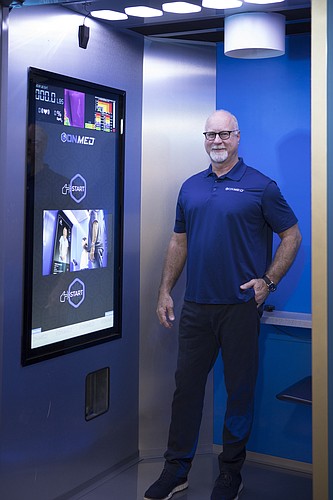- April 18, 2025
-
-
Loading

Loading

Tampa telemedicine company OnMed was about to take off in 2020. Then a global pandemic caused a change of plans. But it wasn’t all bad.
“What happened with COVID-19 was the double-edged sword,” says Austin White, 64, the president and CEO of OnMed. “All the things we were doing — they just came to a screeching halt. It was a big cash flow crunch.”
The company had contracts for four to six OnMed stations — hybrids of virtual and touch-and-feel medicine — poised to start in summer 2020. But those contracts were with health care systems and colleges, and once COVID-19 hit, nonemergency health care was not exactly top priority.
Yet what seemed like a big setback became a giant opportunity. As potentially contagious COVID-19 patients were turned away from physical doctor’s offices, telehealth became the best — and, in many cases, only — option. About 40% of all non-life-threatening medical consults were going through telehealth, White says. An industry that had once been overly regulated and discouraged by insurance providers suddenly became a necessity.
“About six months in, it was just this [epiphany] moment for the world that telehealth was the way to cover this,” White said. “People were saying, ‘We might need to use telehealth.’ Really? That’s a great idea.”
This surge of interest has translated to some significant growth for OnMed. It did less than $1 million in revenue in 2020, its first full year of operation. White expects the firm to grow to between $4.5 million to $5 million in revenue in 2021 and even more next year. The company has 29 employees, about half of which are on the medical side. “I think it’s going to be a breakout year,” he says. “I do believe that 2022 will dwarf 2021.”
White thinks of OnMed as much more than telehealth. He views its product as the future of the field: a combination of the intimacy of brick-and-mortar appointments with the ease and accessibility of a virtual appointment. What sets the company apart from a traditional telehealth phone call with a doctor is the OnMed station. It’s an enclosed space that offers a live consultation with a doctor on video screen, drop-down diagnostic equipment like stethoscopes, in addition to pulse oximeters and a blood pressure monitor and the innovative ability to dispense medication. At the end of every appointment, the station undergoes a cleaning mode that sanitizes the surfaces and air with UV light and ionized air purification.
OnMed’s advanced technology started from humble beginnings. One of the first drawings for an OnMed station was scrawled on the back of a napkin. An ensuing model was created with popsicle sticks and crepe paper. That was enough for the company to start the patent application process in 2012, the same year it was founded.
It took about six years for OnMed to go from patent pending to patent approved. The company now has patents in the U.S. and Israel.
There was a lot of internal confidence in the project from the start — OnMed was entirely self-funded until October 2019. That’s when the first station debuted at Tampa General Hospital, intended to serve the hospital system’s roughly 8,000 employees.
Since then, partially because of COVID-19 slowdowns, the company has only licensed one other station — in rural Milam County, Texas, through a partnership with Texas A&M University. But White says the company is negotiating contracts in eight other states, including Mississippi, Tennessee, Louisiana and North Carolina.
Potential users of the OnMed station might fall into three categories: a large employer or system, such as a university or a hospital; a rural area underserved by urgent care and emergency medical facilities; and a travel hub, such as an airport, where a customer might want health care on the go.
OnMed has two different contract models. First, the equipment is not for sale, but it can be licensed to entities, such as Tampa General, for an upfront license fee valid for three years. Clients must also pay a monthly maintenance and service fee, which comes with a three-year warranty on the electronics. White says those costs are simply enough for OnMed to break even on the units.
“We charge just enough to kind of get it on site and get it moving,” he says. “Where we make money is a membership model.”
Through a membership model, a facility like Tampa General might pay $8 a month per member for perennial use of the OnMed station. Given 4,000 of Tampa General’s employees are on campus, that comes out to roughly $32,000 a month or $384,000 a year. There is no extra charge per consultation, but a medication is additional. (The OnMed station at TGH is for employees, not walk-in patients.)
In a scenario where OnMed is at an airport, White says there would be a per-use fee. That could be $75 or $80, which he says is half the cost of a walk-in clinic visit. And the customer doesn’t have to walk a single step to get a medication, if that’s what they need.
(This story was updated to correctly reflect some of the specific gear and cleaning protocols of the OnMed stations.)